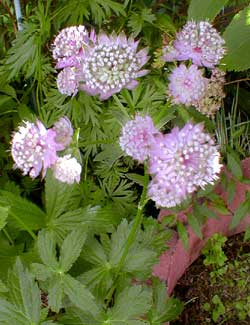
'Lars' Greater Masterwort
"I often see flowers from a passing car
That are gone before I can tell what they are."
-Robert Frost
(1874-1963)
(1874-1963)
Regular wild form of Astrantia major has white pom-pom flowers with a pale violet heart. The cultivar 'Lars' was developed in Denmark. As depicted in a couple of illustrated catalogs, it is evidently quite often blooms a bright ruby-red. But other photos show it to be a much sutbler shade, & ours is of that sort. As blooming in our garden, it merely increases & highlights the violet heart of regular Masterwort, the ruffled pincushions first opening rather pale & aging to a redder maroon, but never achieving the ruby-red brightness.
It appears that 'Lars' is somewhat unpredictable, & at least one grower discribes two strains, "dark red" & "soft red." But I wonder if it it is possible the darker colored 'Lars' come about in more northerly climactic conditions (it is suitable down to a very chilly zone 4), while in our temperate zone the color is simply not as apt to be extreme. But that's just a speculation.
Frankly, the majority of Masterwort cultivars do not contrast with a great deal of difference one type to the next. There are named varieties ranging from white with purple highlights, to pink with white highlights, & all stages in between, but you'd have to set them side by side to really detect the differences.
Even though most of them are extremely similar, Masterwort is such a pleasing clumping perennial with such long-lasting blooms, it is good to have them growing in more than one location in one's gardens. On some emotional level I'd rather add some faintly different variety instead of the exact same flower. Every year there seems to be another "improved" red offered locally, & always the improvement is undetectible. Still, if eventually I see one that is startlingly different from the "natural" form & the pinker 'Lars,' I will happily add another clump somewhere.
'Lars' has thus far remained smaller than the wild clump it grows near. It emerges from the ground a tad later in spring, grows more slowly, & begins blooming a few weeks later, beginning to look really flowery about mid-July. The flowers have the faint perfume of honey & straw.
Masterwort slowly spreads by underground runners. An old clump can be divided in early spring. However, Masterwort is always slow to recover from division, & it should not be done until it is oversized & absolutely necessary. Ours thrive in dappled shade, but they will also do well in much more sun if the soil is never dry.